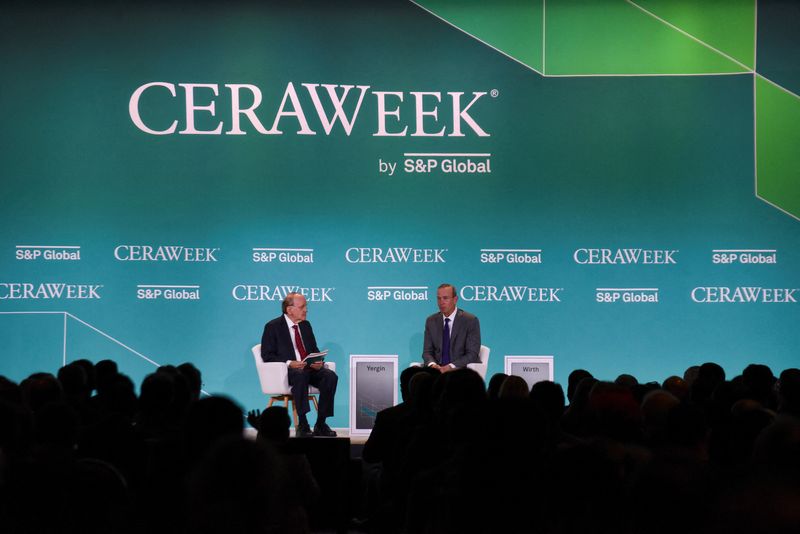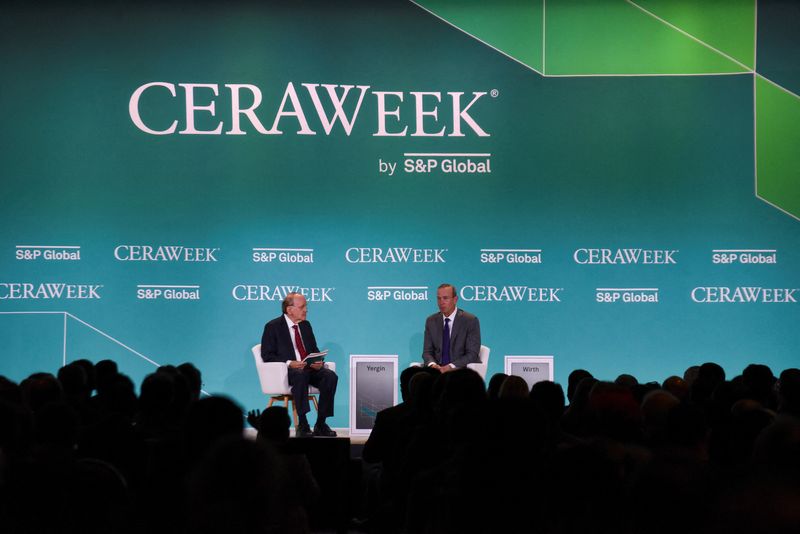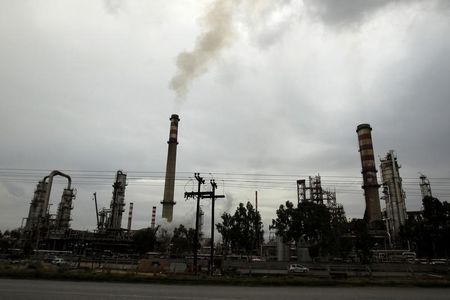Commodities
Oil mergers, clean fuels vie for attention at Houston energy conference


© Reuters. FILE PHOTO: Mike Wirth, the CEO of Chevron Corporation, speaks with Daniel Yergin, the vice chairman of S&P Global, as top energy executives and officials from around the world gather during the CERAWeek 2023 by S&P Global, energy conference in Houston, T
By Arathy Somasekhar
HOUSTON (Reuters) -Top oil executives and ministers descend on Houston this week for one of the world’s biggest energy conferences emboldened by blockbuster mergers, stable oil prices and less pressure for a large-scale move to clean fuels.
Global oil prices have remained in a range between $75 and $85 per barrel, a level fueling profits but not hurting economic growth, despite war in Eastern Europe and turmoil in the Middle East. Stock markets continue to spur deals, making Big Oil even bigger.
The annual CERAWeek conference comes as demand for oil and gas continues to rise alongside solar, wind and biofuels. Energy markets have accommodated a reordering of global flows as customers turn more to regional energy suppliers or live with longer seaborne supply chains.
“A remarkable thing is the (price) stability, given the geopolitical turmoil,” said Daniel Yergin, vice chairman of conference organizer S&P Global and a Pulitzer Prize-winning author on global energy.
Unlike past conferences where conversations were dominated by market-share battles between U.S. shale oil producers and the Organization of the Petroleum Exporting Countries, talk of price wars have been supplanted by energy security issues, Yergin said.
“When demand was down and prices were down, it was very easy to see a way towards energy transition, but with Russia/Ukraine (war) and price shocks, energy security is back on the table,” Yergin added.
More than 7,200 people are expected to hear the latest outlook on energy markets from the heads of top producers’ BP (NYSE:), Chevron (NYSE:), Exxon Mobil (NYSE:), Saudi Aramco (TADAWUL:), Sinopec (OTC:) and Petronas.
Global liquefied (LNG) developments and U.S. climate policies will be a major topic in separate sessions by big exporters Cheniere Energy (NYSE:) and Venture Global LNG, while U.S. Energy Secretary Jennifer Granholm and White House adviser John Podesta press the administration’s climate goals.
While oil prices are strong, natural gas has been overwhelmed by a production glut. But “this year will be a transition year to a much more bullish gas and power market next year,” said Vikas Dwivedi, an energy strategist at financial firm Macquarie Group (OTC:).
Notably absent this year, which occurs during the Islamic holy month of Ramadan, are top oil ministers from Saudi Arabia, Kuwait and Iraq. No officials from Russia are expected after they did not attend last year.
OPEC’s absence comes with global prices hovering around $85 a barrel, a level that Dwivedi said helps cover its members’ budgets, but does not accelerate transition to electric vehicles and renewable fuels.
OPEC forecasts relatively strong oil demand and economic growth, a view that encourages more oil and gas activity and mergers. Last year’s more than $250 billion in U.S. energy deals stirred fears of concentration and a slowing of regulatory approvals.
Climate concerns are reflected in the conference sessions on carbon sequestration technology and hydrogen fuels, which have become two of the oil industry’s favorite means of addressing global warming. The role of artificial intelligence in energy production and carbon emissions are prominent sessions this year.
Energy consumers’ willingness to pay up for clean fuels or for new technologies to address emissions “is a growing issue, as is the ability to generate adequate return on investment” by energy companies, said Joe Scalise, consultancy Bain & Co’s head of energy and natural resources.
A constant topic at the CERAWeek conference in the last decade has been the ups and downs of U.S. shale, which revolutionized energy markets and turned the United States into the world’s No. 1 crude producer and a top exporter.
This year, acquisitions by Chevron, ConocoPhillips (NYSE:) and Exxon Mobil will turn the trio into the largest producers in the top U.S. shale field. That shift promises to tame what was a wild card in global oil production. Big Oil’s investments and production methods may steady shale’s ultra boom-bust cycles.
Commodities
Oil set for weekly gain on signs of improving demand

By Shariq Khan
NEW YORK (Reuters) – Oil prices rose in Asian trading hours on Friday, with global benchmark Brent set for its first weekly increase in three weeks on signs of improving global demand and slowing inflation in top oil consumer the United States.
prices rose 21 cents, or 0.3%, to $83.48 a barrel by 0018 GMT. U.S. West Texas Intermediate (WTI) crude futures rose 18 cents, or 0.2%, to $79.41 a barrel.
Brent futures are set to rise about 1% on a weekly basis, and WTI futures are set to gain 1.4%.
Recent declines in oil and refined products inventories at major global trading hubs have created optimism over oil demand growth, reversing a trend of rising stockpiles that had weighed heavily on prices in prior weeks. Through Thursday, Brent crude futures were down around 10% from this year’s peak of $92.18 a barrel on April 12.
U.S. oil and fuel inventories fell last week, while Singapore’s middle distillate fuel stocks dropped to a near three-month low this week. In Europe’s Amsterdam-Rotterdam-Antwerp trading hub, gasoline stocks were down 7.5% in the week to Thursday, data from consultancy Insights Global showed.
Recent economic indicators from the United States have fed into the optimism over global demand. U.S. consumer prices rose less than expected in April, data showed on Wednesday, boosting expectations of lower interest rates in the country.
Those expectations were further bolstered by data on Thursday that showed a stabilizing U.S. job market.
remove ads
.
Lower interest rates could help soften the U.S. dollar, which would make oil cheaper for investors holding other currencies and drive demand.
“Financial markets now have placed the most bets on a September interest rate cut by the Federal Reserve, which would continue to temper the dollar strength and shift that strength over to commodities and equities,” StoneX oil analyst Alex Hodes said on Thursday.
Commodities
Goldman Sachs discusses what’s next for natural gas prices

Over the past three weeks, US prices have surged 30% to above $2.50 per million British thermal units (mm/BTU), fueled by production declines and increased feedgas demand for liquified natural gas (LNG) exports.
Moreover, recent producer cuts, maintenance events, and Freeport LNG’s normalization of gas demand post-outage have contributed to this rise. Cheniere’s announcement of no heavy maintenance for its liquefaction trains this year also supports higher prices.
In a Thursday note, Goldman Sachs strategists said the return of gas prices above $2/mmBtu aligns with their expectations, as production curtailments “would ultimately lead to lower storage congestion risks for this summer.”
“That said, we see only limited further upside from current levels, with stronger gas prices risking a return of congestion concerns,” they added.
Goldman notes that prices above $2/mmBtu reduce gas competitiveness compared to coal, with a $0.50/mmBtu increase potentially cutting gas demand by 1 billion cubic feet per day (Bcf/d), especially in shoulder months.
Moreover, higher prices may prompt the restart of previously shut-in wells. EQT (ST:), the largest producer in the Appalachia region, indicated it would resume production if prices sustainably exceed $1.50/mmBtu. And while Appalachia prices haven’t risen as much as NYMEX, the local hub has averaged $1.44/mmBtu month-to-date, up 10¢ from last month, strategists highlighted.
Elsewhere, European gas prices have also risen this summer, though less sharply than in the US.
Title Transfer Facility (TTF) prices increased 18% over the past three months to around 30 euros per megawatt-hour (MWh), holding steady in May.
remove ads
.
However, unlike the US market, this rally lacks fundamental support, with Northwest (NW) European gas storage at record-high levels, Goldman strategists pointed out.
“To be sure, NW European LNG imports have remained weak relative to last year – and are likely to get weaker in the coming weeks owing to a seasonal decline in global LNG production, exacerbated by outages at Australia’s Gorgon export project,” they said.
“Going forward, we expect healthy non-European demand for LNG to continue to incentivize a decline in European LNG imports vs last year,” they continued.
Commodities
Gold prices trim some weekly gains on tempered rate cut hopes

Investing.com– Gold prices fell slightly on Friday, trimming some of their gains for the week as comments from a slew of Federal Reserve officials offered a more sobering outlook on interest rate cuts.
The yellow metal had risen to nearly $2,400 an ounce this week in the immediate aftermath of some soft U.S. economic readings. But it pulled back from these levels on Thursday and Friday.
steadied at $2,377.40 an ounce, while expiring in June fell slightly to $2,381.10 an ounce by 00:19 ET (04:19 GMT).
Gold retreats as Fed officials downplay rate cuts, but weekly gains due
The yellow metal fell on Thursday after a string of Fed officials cautioned against bets on immediate reductions in interest rates.
Several members of the central bank’s rate setting committee said the central bank will need much more convincing that inflation was coming down beyond a marginally soft inflation reading for April.
This saw traders begin pricing out some expectations for a rate cut in September. The and also rebounded from earlier losses this week.
Still, some softer-than-expected readings put gold on course for a 0.7% weekly gain.
The yellow metal was also in sight of a record high of above $2,430 an ounce, although it appeared unlikely the level would be met in the near-term.
Other precious metals retreated on Friday, but were set for bumper weekly gains. fell 0.2% but were trading up 6.2% for the week, while fell 0.4% but were up 4.5% this week.
remove ads
.
Copper mixed amid middling China cues
Among industrial metals, one-month copper futures tumbled from two-year highs tracking middling economic data. But three-month copper futures pushed higher and were set for a stellar week as markets bet on tighter supplies and an eventual demand recovery in the coming months.
on the London Metal Exchange rose 0.6% to $10,445.0 a ton, while rose 0.3% to $4.8935 a pound.
Data from China on Friday painted a mixed picture of the economy. While grew more than expected, growth slowed and shrank at an accelerated pace. Growth in Chinese also slowed.
The readings presented a muddled outlook for the world’s biggest copper importer, as it rolled out more stimulus measures to shore up growth.
Three-month copper futures gained on the prospect of a demand recovery, and were up nearly 4% this week. They were also at two-year highs.

 Forex2 years ago
Forex2 years agoForex Today: the dollar is gaining strength amid gloomy sentiment at the start of the Fed’s week

 Forex2 years ago
Forex2 years agoHow is the Australian dollar doing today?

 Forex1 year ago
Forex1 year agoUnbiased review of Pocket Option broker

 Forex2 years ago
Forex2 years agoDollar to pound sterling exchange rate today: Pound plummeted to its lowest since 1985

 Cryptocurrency2 years ago
Cryptocurrency2 years agoWhat happened in the crypto market – current events today

 World2 years ago
World2 years agoWhy are modern video games an art form?

 Stock Markets2 years ago
Stock Markets2 years agoMorgan Stanley: bear market rally to continue

 Economy2 years ago
Economy2 years agoCrude oil tankers double in price due to EU anti-Russian sanctions

































